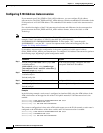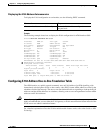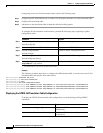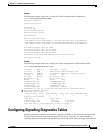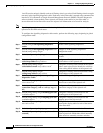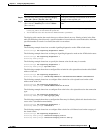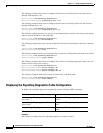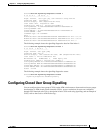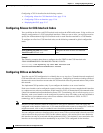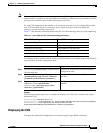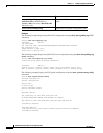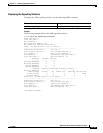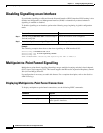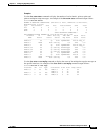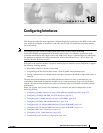
17-16
ATM Switch Router Software Configuration Guide
OL-7396-01
Chapter 17 Configuring Signalling Features
Configuring Closed User Group Signalling
Configuring a CUG is described in the following sections:
• Configuring Aliases for CUG Interlock Codes, page 17-16
• Configuring CUG on an Interface, page 17-16
• Displaying the CUG, page 17-17
Configuring Aliases for CUG Interlock Codes
You can define an alias for each CUG interlock code used on the ATM switch router. Using an alias can
simplify configuration of a CUG on multiple interfaces. When you use an alias, you no longer need to
specify the 48-hexadecimal-digit CUG interlock code on each interface attached to a CUG member.
To configure an alias for a CUG interlock code, use the following command in global configuration
mode:
Example
The following example shows how to configure the alias TEST for the CUG interlock code
4700918100000000603E5A790100603E5A790100.12345678:
Switch(config)# atm signalling cug alias TEST interlock-code
4700918100000000603E5A790100603E5A790100.12345678
Configuring CUG on an Interface
Your first step in CUG configuration is to identify the access interfaces. Transmission and reception of
CUG interlock codes is not allowed over access interfaces. Configuring all interfaces leading outside of
the network as access interfaces ensures that all CUG interlock codes are generated and used only within
this network.
You implement CUG procedures only if you configure the interface as an access interface.
Each access interface can be configured to permit or deny calls either from users attached to this interface
or to unknown users who are not members of this interface's CUGs. In International Telecommunications
Union Telecommunications Standardization Sector (ITU-T) terminology, this is called outgoing access.
Similarly, each access interface can be configured to permit or deny calls either to the users attached to
this interface or from unknown users who are not members of this interface's CUGs. In ITU-T
terminology, this is called incoming access.
Note Interfaces to other networks should be configured as CUG access interfaces, even if no CUGs are
configured on the interface. In this case, if you want the ATM switch router to exchange SVCs with the
neighbor network, calls to and from unknown users should be permitted on the interface.
You can configure each access interface to have one or more CUGs associated with it, but only one CUG
can be selected as the preferential CUG. In this software release, calls received from users attached to
this interface can only be associated with the preferential CUG. Calls destined to users attached to this
interface can be accepted based on membership in any of the CUGs configured for the interface.
Command Purpose
atm signalling cug alias alias-name
interlock-code interlock-code
Configures the alias for the CUG interlock
code.



